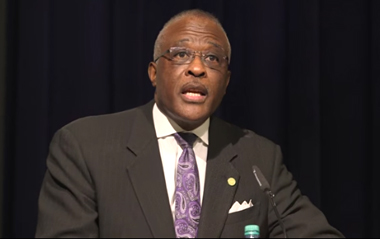A Calling to Diversity, Equity and Inclusion
President Jones tells North Carolina audience that all in academe must be more engaged with external communities and eager for open dialogues on race with a new generation of students.
 |
|
President Jones addressed the topic of institutional cultural change to an audience at North Carolina State University in Raleigh on Wednesday, February 17. |
ALBANY, N.Y. (February 18, 2016) — In delivering the 2016 Humanities and Social Sciences Diversity Lecture at North Carolina State University on Wednesday, President Jones used parts of his life story to impart a message on how academic leaders must advance diversity and inclusion on campus. Part of that story included how, as a boy, he had to name himself.
The son of Georgia sharecroppers, the President was legally only named “RJ.” By the time he was in sixth grade, the state demanded full names, so the youngster came up with Robert James. “But I think I made a mistake with that,” he said. “Nothing wrong with ‘James’ – it’s a fine name. But it’s not the right name for me. I can see that now, 50 years later.
“The name I should have taken was Jonah.”
Why? Because Robert James Jones, whose path had taken him from a young man working multiple jobs just to afford college to a “comfortable and interesting life” as a University of Minnesota research professor, was twice uprooted from this comfort and “called” — called to add to his research career a noble mission: to become a champion of diversity and inclusion in education.
This occurred first in the early 1980s when he was recruited to be part of the South African Education Program. The brainchild of Desmond Tutu, it selected 125 South African and Namibian students per year for collegiate study in America. Through 1994, Dr. Jones worked four to five weeks per year in Africa, helping to find and select these students, who through education would someday be their nations' leaders.
Then, beginning in 1987 at Minnesota, he was called once more: to become engaged with or oversee programs that would bring positive institutional change in diversity and inclusion. This pursuit became an integral part of all his work as he advanced in administrative positions at U of M and then into the presidency of UAlbany.
“I didn’t seek out this mission,” he told the NC State audience. “It found me. And sometimes I feel like I was swallowed by the whale and spit back out. And I think that the lesson for us is that we all have something we are called to do — and we can’t run away from it.”
That mission for all in academia, he said, is that diversity must now be a national economic and moral imperative. “If we don’t harness our institutional energies around equity and diversity, our institutions will be neither just nor sustainable,” said the President. “We won’t be able to meet changing workforce needs. We won’t be able to address the health and economic needs of our communities.”
This work in higher education, he said, must adhere to two rules. One, that people on every level of a campus community become engaged in the mission. “Wherever we are on the organizational chart, we all need to be both diversity leaders and diversity workers. This is everybody’s business, everybody’s job, and everybody’s responsibility — even if it’s not explicitly in the job description.
“In practical terms, that means making sure that both the content of our work and our approaches to our work reflect and deeply embed our commitment to equity and inclusion. It also takes a bold, telescopic vision of where we want to be 10, 20, 50 years from now.”
Such commitment, he said, must necessarily reach out to external communities. A prime example, he pointed out, is the Albany Promise, where UAlbany has become the host institution for a collective impact strategy that enables communities to create a cradle-to-career education ecosystem aimed at effectively closing the achievement gap.
“As income inequality grows, the gap in educational attainment grows right along with it,” said the President. “The severity of this state of affairs is why it is more important than ever for universities to engage in P-12 education. We must work upstream, to assure that more children arrive to us ready for college.”
Rule two, he said, is changing the diversity and inclusion conversations on campus to engage with a new generation of students. “We must recognize that today’s young people think and talk about race in very different ways. They eat together, they study together, and they are mixed in every way possible. Their fashions, their music, and their language are all multicultural. This is ‘the Fusion Generation.’
“Many of our students see diversity in a whole different way. They see it as the normal condition of humanity. They can live this way because of the struggle that our generation and our elders made.”
The President said that conversations with “the Fusion Generation” must of necessity be dialogues, not lectures, and that “we must see to it that our universities are places where ideas and values can be discussed freely. That they are places where people can challenge each other respectfully.”
![]() For more news, subscribe to UAlbany's RSS headline feeds
For more news, subscribe to UAlbany's RSS headline feeds
A comprehensive public research university, the University at Albany-SUNY offers more than 120 undergraduate majors and minors and 125 master's, doctoral and graduate certificate programs. UAlbany is a leader among all New York State colleges and universities in such diverse fields as atmospheric and environmental sciences, business, education, public health,health sciences, criminal justice, emergency preparedness, engineering and applied sciences, informatics, public administration, social welfare and sociology, taught by an extensive roster of faculty experts. It also offers expanded academic and research opportunities for students through an affiliation with Albany Law School. With a curriculum enhanced by 600 study-abroad opportunities, UAlbany launches great careers.


